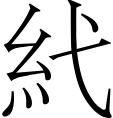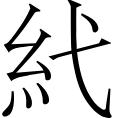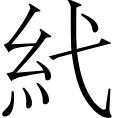Liu Hongtao
There is a sentence “民情不贰(minqing bu er)” in chapter 11 of
Ziyi of the Book of Rites. The corresponding characters of
Ziyi in Guodian bamboo slips and Shangbo bamboo slips are respectively written as “民青不

(binqing bu shi)” and “民情不弋(minqing bu yi)”. The old interpretations are both “民情不忒(minqing bu te)”.Through comprehensively and meticulously sorting out characters and words adaptation relationship related to “饰(shi)” and “饬(chi)” in excavated documents, this article points out that their meaning can be adapted with semantic symbols such as“巾(jin), 糸(幺)(mi), 衣(yi)” and “玉(yu), 金(jin), 贝(bei)” etc., and its sound can be adapted with phonetic symbols such as “食(shi), 弋(yi), 力(li), 来(lai)” etc., resulting in adapted original characters such as“

(shi),貣(shi),糼(shi),

(shi)” etc. Based on this, the character “

(shi)” in Guodian bamboo slips should be a variant of the character “饰(shi)”, and the character “贰(er)” of the Book of Rites should be a mistake of “貣(shi)” and also a variant of the character “饰(shi)”. “饰(shi)” means “to conceal” or “to disguise”. The previous interpretation of “情(Qing)” as referring to “mind”, “psychology”, etc., is wrong. Rather, it should be interpreted as implying the meaning of “sincerity”, “honesty”, etc., the opposite of the meaning of “饰(shi)”. The sentence “民情不饰(minqing bu shi)” means “the people are honest and not disguised”. Ancient rulers have always been concerned about how to ensure the people refrain from concealing or withholding the truth, which is often found in ancient books. Based on the new understanding resulted from the study of characters and words adaptation relationship related to “飾(shi)” and “飭(chi)”, this article reinterprets some related characters and words in unearthed and passed down literature.



 (binqing bu shi)” and “民情不弋(minqing bu yi)”. The old interpretations are both “民情不忒(minqing bu te)”.Through comprehensively and meticulously sorting out characters and words adaptation relationship related to “饰(shi)” and “饬(chi)” in excavated documents, this article points out that their meaning can be adapted with semantic symbols such as“巾(jin), 糸(幺)(mi), 衣(yi)” and “玉(yu), 金(jin), 贝(bei)” etc., and its sound can be adapted with phonetic symbols such as “食(shi), 弋(yi), 力(li), 来(lai)” etc., resulting in adapted original characters such as“
(binqing bu shi)” and “民情不弋(minqing bu yi)”. The old interpretations are both “民情不忒(minqing bu te)”.Through comprehensively and meticulously sorting out characters and words adaptation relationship related to “饰(shi)” and “饬(chi)” in excavated documents, this article points out that their meaning can be adapted with semantic symbols such as“巾(jin), 糸(幺)(mi), 衣(yi)” and “玉(yu), 金(jin), 贝(bei)” etc., and its sound can be adapted with phonetic symbols such as “食(shi), 弋(yi), 力(li), 来(lai)” etc., resulting in adapted original characters such as“ (shi),貣(shi),糼(shi),
(shi),貣(shi),糼(shi), (shi)” etc. Based on this, the character “
(shi)” etc. Based on this, the character “ (shi)” in Guodian bamboo slips should be a variant of the character “饰(shi)”, and the character “贰(er)” of the Book of Rites should be a mistake of “貣(shi)” and also a variant of the character “饰(shi)”. “饰(shi)” means “to conceal” or “to disguise”. The previous interpretation of “情(Qing)” as referring to “mind”, “psychology”, etc., is wrong. Rather, it should be interpreted as implying the meaning of “sincerity”, “honesty”, etc., the opposite of the meaning of “饰(shi)”. The sentence “民情不饰(minqing bu shi)” means “the people are honest and not disguised”. Ancient rulers have always been concerned about how to ensure the people refrain from concealing or withholding the truth, which is often found in ancient books. Based on the new understanding resulted from the study of characters and words adaptation relationship related to “飾(shi)” and “飭(chi)”, this article reinterprets some related characters and words in unearthed and passed down literature.
(shi)” in Guodian bamboo slips should be a variant of the character “饰(shi)”, and the character “贰(er)” of the Book of Rites should be a mistake of “貣(shi)” and also a variant of the character “饰(shi)”. “饰(shi)” means “to conceal” or “to disguise”. The previous interpretation of “情(Qing)” as referring to “mind”, “psychology”, etc., is wrong. Rather, it should be interpreted as implying the meaning of “sincerity”, “honesty”, etc., the opposite of the meaning of “饰(shi)”. The sentence “民情不饰(minqing bu shi)” means “the people are honest and not disguised”. Ancient rulers have always been concerned about how to ensure the people refrain from concealing or withholding the truth, which is often found in ancient books. Based on the new understanding resulted from the study of characters and words adaptation relationship related to “飾(shi)” and “飭(chi)”, this article reinterprets some related characters and words in unearthed and passed down literature.